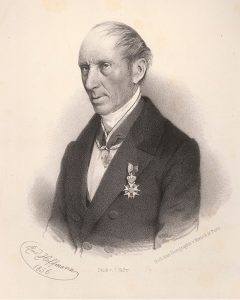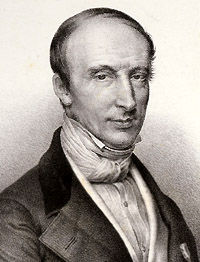“George Sarton, a founder of the history of science as an academic discipline, argued that scholars should pay close attention to portraits. These images, he said, can give you ‘the whole man at once.’ With a ‘great portrait,’ Sarton believed, ‘you are given immediately some fundamental knowledge of him, which even the longest descriptions and discussions would fail to evoke.’ Sarton’s ideas led Bern Dibner to purchase portrait prints of men and women of science and technology. Many of these are now in the Smithsonian’s Dibner Library of the History of Science and Technology.” – Deborah Jean Warner, Curator, Physical Sciences Collection
A picture may tell 1000 words, but another 500 for context can add depth to the image. Follow this blog series to discover the people behind the portraits available online in the Scientific Identity collection.

Augustin-Louis Cauchy (August 21, 1789 – May 23, 1857)
Baron Augustin-Louis Cauchy, one of the greatest mathematicians of the 19th century, was not the most beloved of men. He held rigid religious and political beliefs that allowed little flexibility in an age of political and religious turmoil in France. In his austere portrait on the right, pinned to his lapel, is Cauchy’s National Order of the Legion of Honor medal, a decoration for his service to France as a military engineer under Napoleon. Though his first position was working on fortifications for Napoleon’s English invasion in 1810, Cauchy’s refusal to accommodate the changing political tides during his lifetime put a damper on his scientific ambitions. In spite of it all, Cauchy still managed to publish an astounding 789 mathematics papers and had sixteen concepts and theorems named for him. He was outstanding not only as a leading representative of the French school of mathematical analysis but for his meaningful contributions across the discipline.
Born on August 21, 1789, just a month after the storming of the Bastille, Cauchy’s family fled Paris and stayed in the village of Arceuil for much of his childhood. The family subsisted on very little, with his father writing in a letter “We never have more than a half pound of bread – and sometimes not even that. This we supplement with the little supply of hard crackers and rice that we are allotted.” In 1800, once it was deemed safe, the family moved back to Paris where Cauchy’s father was appointed Secretary of the Senate. His father’s position brought such luminaries as Pierre-Simon de Laplace and Joseph-Louis Lagrange into their circle, both recognizing Cauchy’s underlying mathematical genius early on and advising on his education.

Having graduated with a degree in civil engineering, Cauchy found the time to publish several significant mathematical papers while working on port facilities for the French fleet under Napoleon. He thrived under the workload, writing home “I get up at four o’clock each morning and I am busy from then on. … I do not get tired of working, on the contrary, it invigorates me and I am in perfect health… .” His work allowed him claim to fame in mathematics circles, though his religious rigidity prejudiced many against him. “So they are claiming that my devotion is causing me to become proud, arrogant and self-infatuated. … I am now left alone about religion and nobody mentions it to me anymore…” His Catholicism forced him to side with the Jesuits against the Academie des Sciences, creating a difficult path to navigate in his attempts at gaining an academic appointment.
Between 1810 and 1817 Cauchy was turned down for at least 6 academic posts, all the while producing a strong mathematical output and winning the Grand Prix of the French Academy of Sciences for a work on waves. He was finally offered a post at the College de France in 1817 but did not inspire much collegial spirit. In 1826 Niels Henrik Abel, Norwegian mathematician who died just 3 years later at age 26, wrote “Cauchy is mad and there is nothing that can be done about him, although, right now, he is the only one who knows how mathematics should be done.”
After Charles X was deposed, Cauchy, having just left for Switzerland to help establish the Academie Helvetique, refused to swear an oath of allegiance to the new king, forfeiting all of his positions in France. He was invited to teach in Torino, Italy for a year but was unable to translate his genius to his students. It was said his courses “were very confused, skipping suddenly from one idea to another, from one formula to the next, with no attempt to give a connection between them. His presentations were obscure clouds, illuminated from time to time by flashes of pure genius. . . . of the thirty who enrolled with me, I was the only one to see it through.”

He then left in 1833 to Prague to tutor the grandson of Charles X for the next five years. It was a difficult arrangement for both tutor and student, leaving the grandson with a lifelong distaste for math. In 1838, Cauchy returned to France and regained his position at the Academy but not his teaching positions, as he continued to refuse to take the oath. It wasn’t until 1848, when King Louis-Philippe was overthrown, that Cauchy was allowed to regain his university positions.
Cauchy’s collected works are published in 27 tomes. The sheer volume of his work is made even more impressive by its incredible depth. Despite being constantly shunned by the scientific establishment in France Cauchy managed to leave a lasting legacy of mathematical discovery.
All quotes from B. Belhoste’s Augustin-Louis Cauchy. A Biography (New York, 1991).
Additional sources:
Dictionary of Scientific Biography (1971), v. 3 (p. 131-147).
J J O’Connor and E F Robertson , University of St Andrews, School of Mathematics and Statistics. 1997. http://www-groups.dcs.st-and.ac.uk/history/Biographies/Cauchy.html
List of relevant Smithsonian Libraries holdings:
Sept leçons de physique générale, / par Augustin Cauchy. Avec appendices sur l’impossibilité du nombre actuellement infini; l’antiquité de l’homme; la science dans ses rapports avec la foi, par l’abbé Moigno.
Cauchy, Augustin Louis, Baron, 1789-1857.
QC71 .C37
Imprint: Paris, Bureau du Journal Les Mondes, 1868.
Collection: Special Collections (Dibner Transfer)
Mémoire sur le système de valeurs : au’il faut attribuer à di vers élémens déterminés par un grand nombre d’observations, pour que la plus grande de toutes les erreurs, abstractions faite du signe devienne un minimum / / présenté à la première classe de l’Institut le 28 févier 1814, par M. A. L. Cauchy.
Cauchy, Augustin Louis, Baron, 1789-1857.
QA331 .C37 1831
Imprint: [Paris : s.n., 1831].
Collection: Special Collections (Dibner)
Papers [manuscript].
Cauchy, Augustin Louis, Baron, 1789-1857.
MSS 000314 A
Imprint: 1822-1831.
Collection: Special Collections (Dibner)
Mémoire sur le nombre des valeurs qu’une fonction peut acquérir lorsqu’on y permute de toutes les manières possibles les quantités qu’elle renferme / / par A.L. Cauchy, ingénieur des ponts et chaussées.
Cauchy, Augustin Louis, Baron, 1789-1857.
QE509 .F77 1827
Imprint: [Paris : s.n., 1813]
Collection: Special Collections (Dibner)
Exercices d’analyse et de physique mathematique / / par Baron Augustin Cauchy.
Cauchy, Augustin Louis, Baron, 1789-1857.
QA2 .C37 1840
Imprint: Paris : Bachelier, 1840-1847.
Collection: Special Collections (Dibner Transfer)
Leçons de calcul différentiel et de calcul intégral / / rédigées d’après les méthodes et les ouvrages publiés ou inédits de A.-L. Cauchy, par M. l’abbé Moigno ; tome quatrième – premier fascicule, calcul des variations ; redigé en collaboration avec M. Lindelöf.
Moigno, abbé (François Napoléon Marie), 1804-1884.
QA315 .M65 1861
Imprint: Paris : Mallet-Bachelier …, 1861.
Collection: Special Collections (Dibner)

Be First to Comment